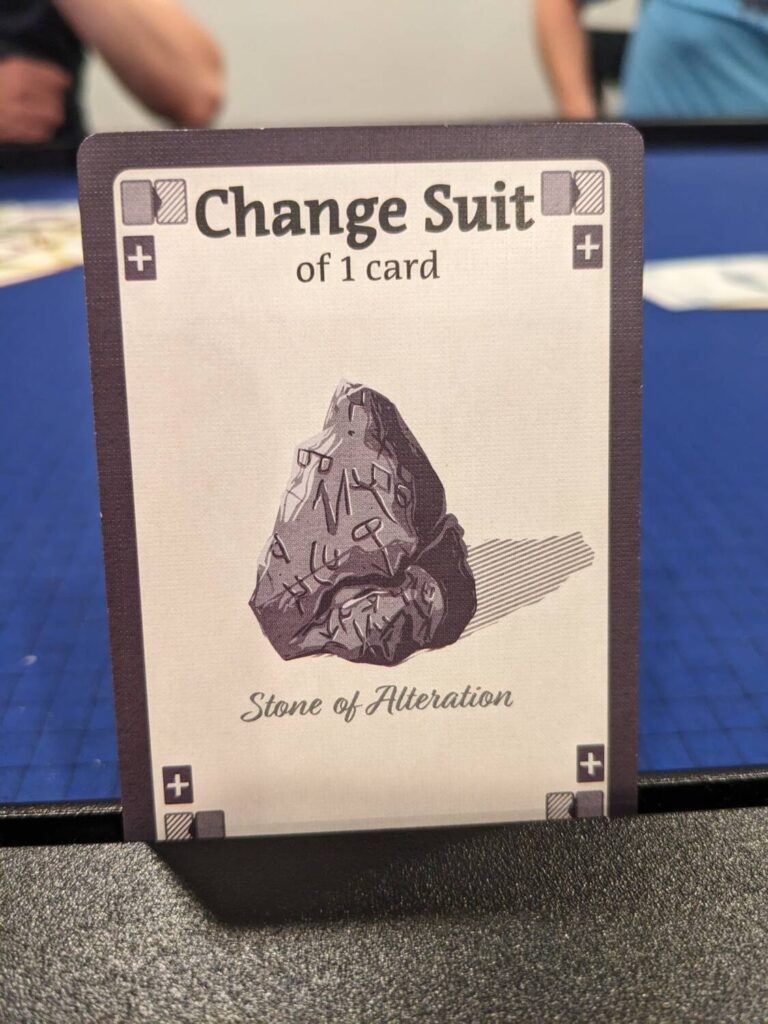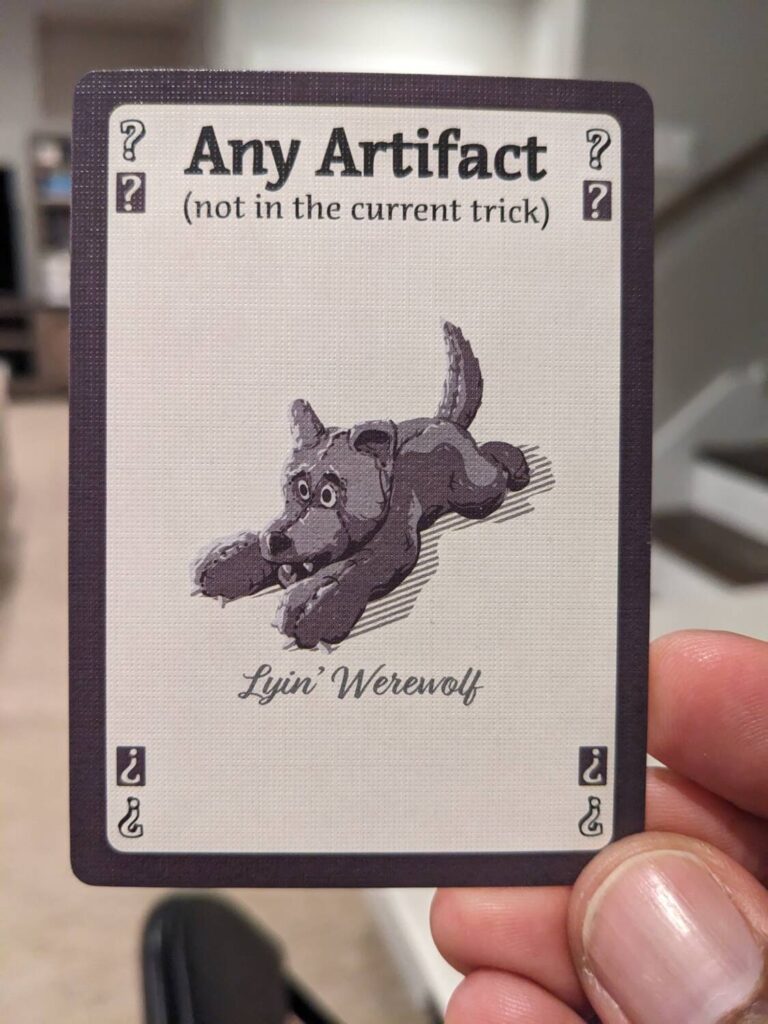Disclosure: Meeple Mountain received a free copy of this product in exchange for an honest, unbiased review. This review is not intended to be an endorsement.
I’ll just admit it upfront: the lack of theme integration in the new shedding game Seers Catalog (2024, Bézier Games) is one of the biggest disappointments of the year.
That’s not because the card art isn’t great. Rather, each of the game’s 60 main cards, and roughly 20 “Artifact” cards, have fun images of various items that a “seer” might need to run their magic trade in the world imagined by the game’s brief introduction.
I am disappointed because when I saw the game’s box back at TantrumCon earlier this year, I thought back to all the years I spent growing up with a Sears, Roebuck & Co. mail order catalog in my hands, pining for the shiny new toys I wanted for Christmas. That catalog was a beast, wasn’t it? And it was always fun to skip through the sections that didn’t matter when I was a kid—so, anything tied to clothes or hair care products or Craftsman tool sets or home goods.
I skipped straight to the toys and games section and stared lovingly into the eyes of Matchbox cars, GI JOE figures, and army men positioned just so. Gosh, I might argue that just like a good movie preview versus the movie featured in the preview, the Sears catalog was sometimes better than actually getting the toys. (Sometimes.)
Seers Catalog, the game, is a straightforward shedding game augmented by an exceptionally wild mechanic called Artifacts, which helps players break a lot of the base game’s rules. Then the game uses a scoring mechanic that makes everything even more interesting as everyone tries to manage their dwindling hand of cards.
The break point for Seers Catalog is a tricky one—the player count is absolutely crucial to the game sticking the landing, assuming you can teach this game to people who can understand the scoring system.

Shed, But Just Enough
Seers Catalog is a 2-5 player “shedding” game, where players must start a round with a hand of cards and get rid of as many cards as possible by playing sets (multiple cards of the same number across different suits), suited runs (consecutive ascending numbers of the same suit), or single cards based on the format that was led at the start of each new trick.
The hook with Seers Catalog is unique across games I have tried in this category—the best way to play is to let someone else shed their entire hand, which scores zero points, then end the hand with just a few cards, ideally cards of a high value.
Players begin a round with a number of cards based on player count, across as many as five suits with a value range of anywhere from 2-13. As players shed their hand, they can choose to play into the trick or pass, but players can only choose to pass until they are down to a hand of five or fewer cards. Then, that player moves into a status called In the Bonus, which allows a player to score points based on their end-of-round cards and the value on those cards…but they must play cards if they can.
As soon as anyone plays their final card, the round immediately ends, even if that happens during a trick.
Scoring can be confusing and takes a moment to explain. Let’s say Jonny goes out first; Jonny, with no cards left in hand, scores zero points. You are In the Bonus because you have three cards left, and those cards are valued at 2, 6, and 10. Your score will equate to the value of the lowest card left in hand, minus the total number of cards you had left. In this case, that total would be -1 (two points for your lowest card, minus three points for having three cards, for a total of negative one).
Anyone who is not In the Bonus gets totally hosed—they score a zero, minus the number of cards they have left in hand. So, that guarantees a score of at least negative six (because that player was not In the Bonus, ensuring they had at least six hand cards), and sometimes a score can be much worse.
Play continues across four rounds, and the player with the highest score will win.
In Seers Catalog, more often than not, low scores or barely negative scores often win the game. This distinction made Seers Catalog a hard game to explain to non-gamers. At least in my circles, Seers Catalog is a card game for gamers (nothing wrong with this, it just means that for me the game’s accessibility is limited) and it will probably not see much play in our family.
The scoring element gives Seers Catalog something to talk about. Then those Artifact cards bring the heat.

The Artifact Cards are Something Else
In each game, two Artifact cards and one wild card per player are shuffled and distributed separately after the entire deck of regular cards is dealt to the table. These cards range from a “Go First” card that indicates who will lead off each round, to the Unique Meld card that lets a player do things so crazy I had to consistently go back to the separate Artifact rulebook to see if a play was even legal.
The Artifact cards are ridiculous. And, they are the main reason why you should play Seers Catalog.
There’s really no game here without the Artifact cards. But with them, a number of things happen—
- Nearly every trick becomes unpredictable, in a good way (at least, from my perspective).
- Winning a trick does not guarantee that you will lead off the next trick, because a couple of the Artifacts break the rule that a player can start a trick, win, then start the next trick.
- Getting rid of Artifact cards is crucial because each one is worth zero points if a trick ends with Artifacts still in hand. If a player In the Bonus has one amongst their remaining cards, that player’s lowest score is suddenly zero minus the number of remaining cards, which essentially defeats the purpose of trying to hold out and letting an opponent shed all their cards to end a round.
Artifact cards, paired with the wild cards, make every round of Seers Catalog more intense—as long as there are a lot of players. Which brings us to my main issue with Seers Catalog: the player count.
At four or five players, there are 8-10 Artifacts in the game. This is fantastic, if you can embrace the chaos. Sometimes, a player thinks they have accurately counted out the cards in the game and figure they have a chance at a play that could end the round. Then someone whips out the ½ Artifact, which is a card that is exactly a half point higher than the card that might have been the highest card left in the game. Wild.
With lots of players, every round—and almost every trick—is tense. A player might be able to play along the fringe and end up with 2-3 cards left at the end of a round, with all of them being fives, sixes, or something higher. The Artifact cards in each game are consistent across rounds, so by the fourth round, you know which Artifacts have not been played to the table and you can plan around them (maybe just a little).
With three players, cracks begin to show. With only six Artifacts in the game, there’s less going on. Every player has a bigger hand of cards, and that hand might have some lucky synergy that allows a player to pull off a big suited run with no way to combat it. If a single round goes badly, it can be hard to recover if you get caught with your pants down and score a -8 or worse in a single round.
At two players, Seers Catalog was predictably uninteresting. Three suits are included in the deck, with three numbers removed from each suit before the game even begins. In each round, the remaining 27 cards are shuffled, three are removed, then the other 24 cards are dealt equally to the two players. Only four Artifacts are used in the two-player format, and one of those has to be the Go First card every game of Seers Catalog requires, so only three unique Artifacts are in there.
My game of Seers Catalog at two players was my worst and least interesting play. Almost zero tension. Multiple ridiculous plays took place in each trick. We had back-to-back rounds where someone played a six-card suited run, so half of a player’s hand came out at once. The time that I did it, the other player played a higher six-card run in the same round before pulling off another one in the following round. The game became an almost totally luck-driven experience, and the winner ended up with the worst winning score I saw in my plays (-4).

At Max Player Count, Get the Catalog (By Mail, Of Course)
Seers Catalog is a fun one, as long as the player count is high. That’s true with a lot of my favorite card games (including some from what can only be described as a banner year for Bézier’s catalog with Xylotar and Rebel Princess: Deluxe Edition), so it is not a surprise that Seers Catalog works so well with more players. The dropoff when playing with two or three players was severe.
I loved how wild each round was with more players. Here, the scoring process lends itself to real drama. The mix of planning and a little luck that was required to end up In the Bonus was always interesting, and games created real narrative as players recounted their tales of victory (or massive defeat) was always a blast.
The main negative is a personal one—Seers Catalog could be about anything, so the theme is basically wasted for someone hoping to take a trip down mail catalog memory lane. Yeah, I know, most games have a theme that can feel pasted on and that’s fine. But a number of players (five unique players joined me for my three plays) commented on the fact that they didn’t even look at the cards during the game, and even afterwards, there wasn’t much to do with a magic item mail-order catalog series of images on the cards.
There is zero interaction with the catalog thing. Oh well.
If you like ladder climbing/shedding-style card games and a good bit of chaos in your games at the max player count, Seers Catalog is a must. Players hoping for an interesting low player count experience, though, should look elsewhere.












Add Comment